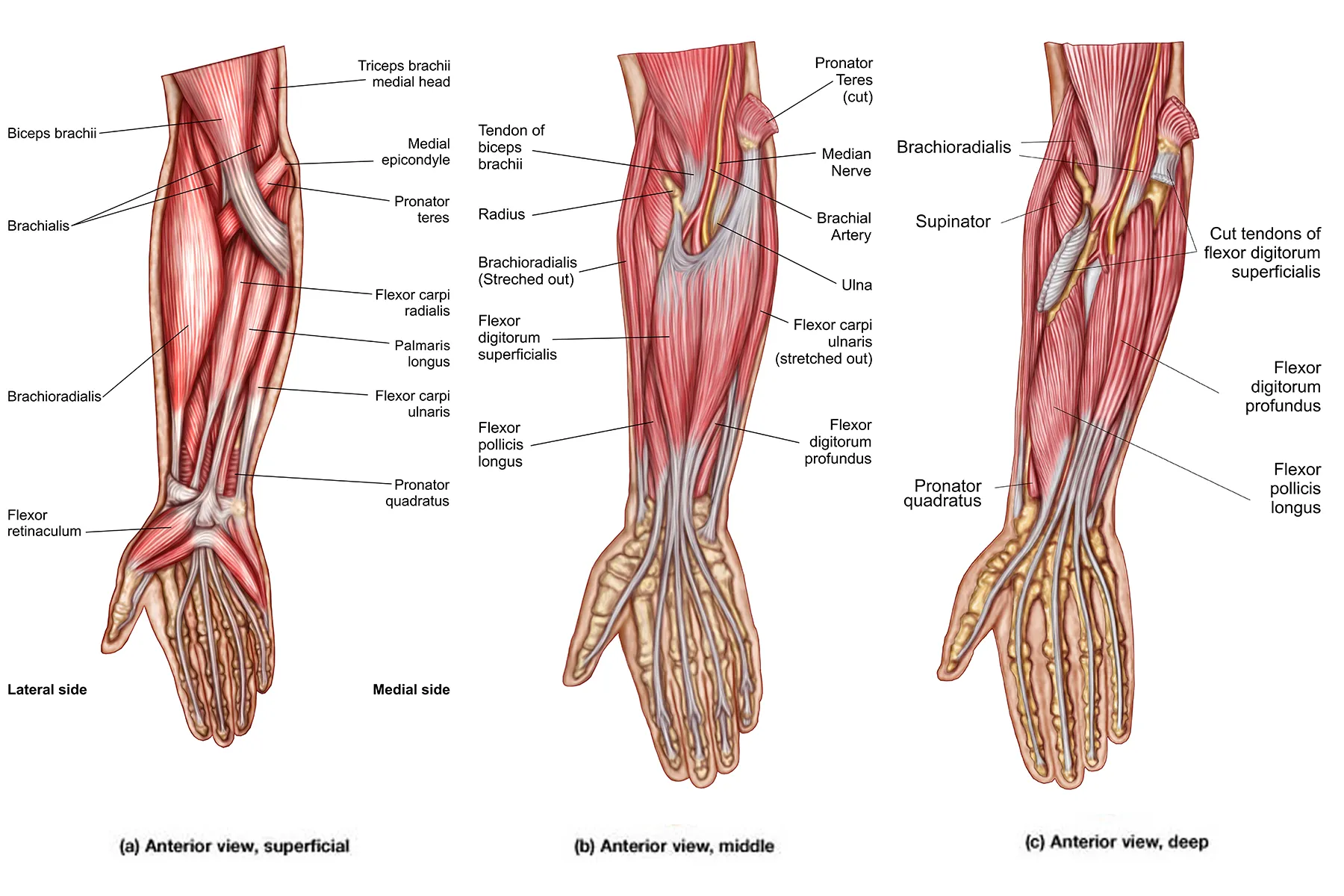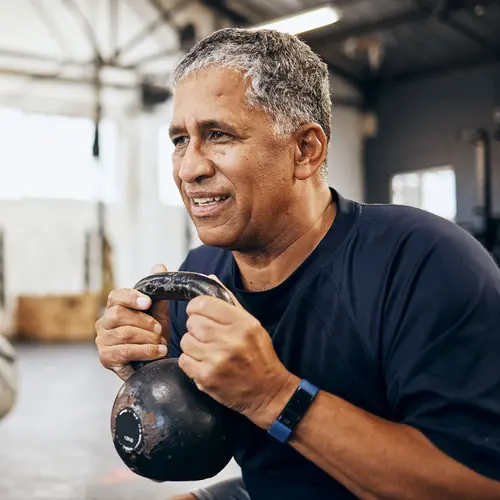Forearm Muscles

You have 20 muscles in your forearm, the part of your arm between your elbow and your hand. They help you move your arms, hands, and fingers and perform many of the tasks of daily life. You can strain a muscle in your forearm if you lift something that's too heavy or overuse your arms.
These muscles are supported by the two forearm bones, the ulna and radius, which form a joint that rotates to let you turn the palm of your hand up or down. Two large arteries, also called the ulna and radius, run the length of your forearm and branch into smaller veins that serve the forearm muscles.
Forearm muscles anatomy
There are two basic categories of forearm muscles:
Intrinsic. These muscles move your forearm by turning the bones inward (toward your body) and outward (away from your body).
Extrinsic. These muscles help you bend and extend your fingers and thumb.
Your forearm muscles are contained in two main compartments: anterior (front) and posterior (rear). These compartments are separated by the two forearm bones plus a membrane that separates them. Inside each compartment are layers of muscles that run from deep inside your arm to near the surface of your skin.
The Anterior Compartment
The anterior compartment has three layers of muscle: superficial (closest to your skin), intermediate, and deep. In general, the muscles here help you turn your forearms and bend, or flex, your wrist and fingers.
Superficial layer
This layer of the anterior compartment contains four muscles that begin near your elbow:
- The pronator teresmuscle mainly works to rotate your forearm.
- The flexor carpi radialis helps move your arm away from your body.
- The palmaris longus helps flex the wrist, so you can wave at a friend or say goodbye to a loved one. About 15% of the population doesn't have this muscle.
- The flexor carpi ulnarislets you move your wrist back and forth.
Intermediate layer
The flexor digitorum superficialis is the only muscle in the intermediate layer. It splits into four tendons that attach to finger bones. It helps you bend your fingers and move your wrist.
Deep layer
- The flexor digitorum profundus allows you to bend your ring, middle, index, and pinkie fingers.
- Theflexor pollicis longus allows you to bend your thumb.
- The pronator quadratus is a square-shaped muscle that lets you turn your forearm downward.
The Posterior Compartment
This compartment has two layers, superficial and deep. The muscles here mostly help you extend, or straighten, your fingers and wrists.
Superficial layer
- The brachioradialis muscle allows you to bend your elbow -- for example, to lift a glass of water to your mouth. It also helps you turn your arm.
- Both the extensor carpi radialis longus and extensor carpi radialis brevisextend your wrist and move your hand away from the direction of your thumb.
- The extensor digitorum splits into four tendons and connects to the finger joints. It helps you straighten or extend your fingers.
- The extensor digiti minimi extends the little finger.
- The extensor carpi ulnaris helps you turn and extend your wrist.
- The anconeus, near the top of the superficial layer, helps extend your forearm at the elbow.
Deep layer
- The supinator muscle allows you to supinate your forearm, which means to turn it so that your palm faces up.
- The extensor pollicis brevis allows you to make a thumbs-up signal.
- Your extensor pollicis longus muscle extends the thumb.
- The extensor indicishelps extend your index finger.
- Your abductor pollicis longus abducts the thumb, or moves it away from the palm.
What Do Forearm Muscles Do?
Your forearm muscles help you make complicated movements with your arm, elbow, wrist, and fingers, such as:
- Turn the palms of your hands up and down
- Bend, straighten, and stretch out your wrists and fingers
- Turn your hands toward and away from your body
- Move your fingers and thumbs
You use the muscles in your forearm in many ways in your daily life, ranging from carrying heavy bags of groceries to playing basketball. Strengthening these muscles can also increase your grip strength. A firm grip helps you do everything from opening a pickle jar to holding a pickleball racquet.
These muscles also help you build strength in other areas of your body. Because forearm muscles are involved in your grip, you use them in many exercises you do at the gym. Moves like rows, kettlebell swings, deadlifts, and bicep curls can be challenging if you lack forearm strength.
Forearm Muscle Conditions
Some conditions that can affect the forearm muscles include:
Muscle strain. This common condition happens when you stretch the fibers of a muscle too far, leading to a tear. You could do this when you:
Overuse a muscle
Put sudden stress on it (such as by lifting a heavy item)
Get an injury
You're more likely to strain a forearm muscle if you:
Perform the same motion repeatedly
Lack flexibility
Don't warm up before you exercise
Rhabdomyolysis. This is a rare and sometimes fatal condition in which your muscle fibers to break down, or disintegrate. Parts of them can get into your kidneys and bloodstream and lead to organ damage. It most often affects athletes who do high-intensity or endurance exercise, but can also result from
- A serious injury or burn
- Drug or alcohol abuse
- Serious dehydration or overheating
- Certain medications or medical conditions
Volkmann's ischemic contracture. This rare condition can cause your hand, fingers, and wrist become to permanently misshapen, usually after an injury to your forearm muscles. It happens when swelling in the area cuts off blood flow to the nerves and muscles. This makes them become shorter and stiffer. It can affect just a couple of fingers, or your whole forearm.
Signs of forearm muscle condition
The symptoms of a forearm muscle strain could include:
- Pain in your forearm, wrist, or hand
- Bruising
- Swelling
- Muscle weakness
- Trouble making certain movements
Most muscle strains are mild and will heal on their own with rest. A more serious strain might need treatment from a doctor.
Symptoms of rhabdomyolysis include:
- Pain in the forearm muscles
- Swelling
- Muscle weakness
- Pee that looks dark or reddish
You might notice these symptoms 1-3 days after an intense workout. If you have signs of rhabdomyolysis, get medical attention right away. You'll probably need to get fluids through an IV in the hospital.
Symptoms of Volkmann's contracture include:
- Numbness in the forearm area
- Weak muscles
- Pale skin
- Your hand takes on a claw-like shape
See a doctor quickly if you've injured your elbow or forearm and notice swelling, numbness, and pain. They may be able to correct the issue with stretching and splints, or you may need surgery for a more serious case.
Treatments for Forearm Muscle Injuries
If you think you may have strained a forearm muscle, it's important to see your doctor to get a diagnosis.
A minor strain may respond to home treatments such as:
The RICE method. This stands for rest, ice, compression, and elevation:
- Use the injured forearm as little as possible until it's healed.
- Apply a cold pack to the area several times a day for 15-20 minutes at a time.
- Wrap a stretch bandage around the area to keep swelling down.
- Use a prop or pillows to keep the forearm raised above your heart whenever possible.
Over-the-counter medications. Drugs like aspirin, acetaminophen, and naproxen may relieve the pain of a strained muscle. Always use them as directed, and don't take them for longer than 10 days.
Stretching. Gentle stretching might help ease pain and tightness once the strain is healing. Never do any stretch that hurts.
Some people also get muscle pain relief from alternative treatments like massage therapy or acupuncture done by a trained practitioner. It's a good idea to check with your doctor before trying one of these approaches.
For a more serious strain, your doctor may recommend:
Physical therapy. A therapist will teach you gentle exercises to strengthen the muscles after a muscle strain.
Surgery. This is rarely needed, and only for a muscle tear that's very serious.
How to Strengthen Arm Muscles
Here are some exercises you can try to strengthen your forearm muscles:
- Carry a heavy object -- a suitcase, a dumbbell, a tire -- and walk for as long as possible. Set the item down, then pick it back up. Repeat this until you get tired.
- If you have access to a sturdy bar, try pull-ups or chin-ups.
- At the gym, grab a couple of dumbbells and hold them out in front of you until you're exhausted.
- Reverse curls (done with a palms-down grip), forearm curls (in which you use your wrist to curl a lightweight upward), or hammer curls will also build forearm strength.
Activities like gardening, pulling weeds, or hammering also strengthen your arms and hands. Using a hand grip trainer device or repeatedly squeezing a tennis ball will help you build a stronger grip.
Forearm Muscle Stretches
To ease or prevent pain in your forearms and wrists, try these stretches:
- With your arms held out in front of you, make a fist with both hands. Roll both wrists clockwise, then repeat the move in the other direction.
- Hold one arm out in front of you with the wrist bent so that your palm faces your body. Use the other hand to gently pull that hand toward your arm. Hold for a few seconds, then switch to the other side.
- Hold an arm out in front of you again, this time with the palm facing up. Bend the hand backward toward your body, and use the other hand to gently pull it down. Hold briefly, then repeat on the other side.
Takeaways
The 20 muscles in your forearms help you make complex movements with your arms, hands, and fingers. They also play an important part in grip strength. Keeping them strong can help you with sports and strength training as well as activities of daily life like carrying items and opening jars.
Forearm Muscles FAQs
What are the forearm muscles called?
Your forearm anatomy includes 20 muscles, ranging from the extensor carpi radialis longus to the abductor pollicis longus. One of the largest is the brachioradialis, which helps to bend your elbow. It extends from the humerus bone in your upper arm to the radius bone.
Why do my forearms hurt?
Some common causes of forearm pain include:
- A muscle strain or other injury
- Repetitive strain injuries like carpal tunnel syndrome or radial tunnel syndrome
- An infection such as osteomyelitis


